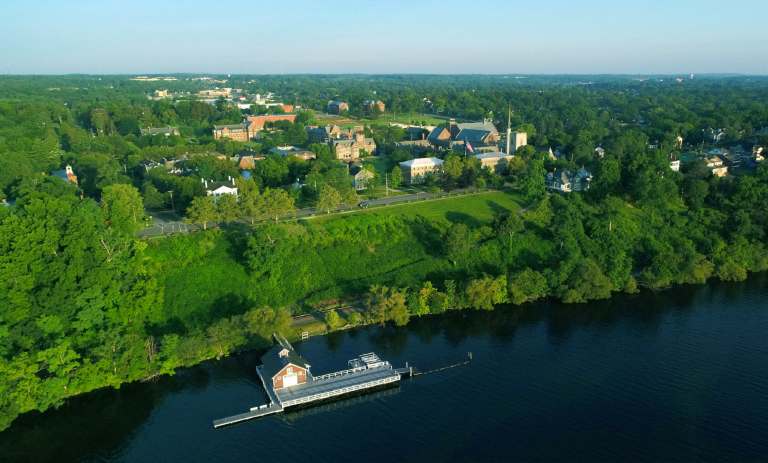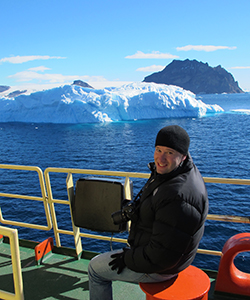
Lives of Consequence
Matt Lamanna '97

Associate Curator of Vertebrate Paleontology Carnegie Museum of Natural History
Considered to be a pivotal contributor to the understanding of how dinosaurs and their environments evolved through time, Matt Lamanna ’97 has travelled to all seven continents on paleontological expeditions. In Egypt, he was on the team that discovered one of the largest dinosaurs that ever lived -- a discovery that is hailed as one of the most significant paleontological finds in recent history. Lamanna also travelled to China as part of the team that found a new species of ancient waterbird, one of the oldest members of a group that eventually led to the evolution of today’s birds.
Raised in upstate New York, Lamanna attended HWS, double-majoring in biology and geoscience. He graduated with high honors and was awarded the Sigma Xi Scientific Research Society prize. After graduation, he went on to study dinosaur paleontology in the Department of Earth and Environmental Science at the University of Pennsylvania, earning his M.S. and Ph.D.
In 2000, while pursuing his Ph.D. at Penn, Lamanna travelled to Egypt with fellow Penn graduate student Joshua Smith to search for a lost dinosaur site first discovered by a German paleontologist in 1911. There, they discovered a new species of giant sauropod (long-necked plant-eating dinosaur) that they named Paralititan stromeri (“tidal giant”) because it died in what was an ancient coastal environment. The expedition was chronicled in the two-hour A&E documentary The Lost Dinosaurs of Egypt and a book by the same name published by Random House. The research received coverage in many major national and international publications and programs, including CNN, The New York Times, USA Today, Reuters, NPR, the BBC, National Geographic, the Charlie Rose Show, and the Associated Press. An article about the find appeared in the preeminent journal Science.
Lamanna now serves as an associate curator of vertebrate paleontology at Carnegie Museum of Natural History in Pittsburgh. Hired in 2004, Lamanna became the first full-time dinosaur paleontologist on the Museum’s staff since the early 20th century. In 2007 and 2008, he served as lead scientific adviser for the Museum’s $36 million, 22,000-square-foot Dinosaurs in Their Time exhibition -- the country’s third largest exhibit of mounted original dinosaur skeletons. In Dinosaurs in Their Time, the Museum’s historic Dinosaur Hall was expanded and updated to display dinosaurs in the context of the most current research.
Since 2012, Lamanna has been the director of the Antarctic Peninsula Paleontology Project, which has discovered literally tons of fossils from the end of the Age of Dinosaurs in the remote James Ross Basin of Antarctica. In early 2014, he led the description of the bizarre bird-like dinosaur Anzu wyliei, better known as the “Chicken from Hell,” and more recently, he co-named three new sauropod species from Argentina, Dreadnoughtus schrani, Notocolossus gonzalezparejasi, and Sarmientosaurus musacchioi.
In 2018, Lamanna coauthored a study that detailed the discovery of a new species of large dinosaur. The find came in 2013 in the Dakhla Oasis of the Egyptian Western Desert. The fossil remains are uniquely intact and help clarify hypotheses about the historical biogeography of giant sauropods. Mansourasaurus shahinae, a long-necked plant-eating dinosaur that lived in what is now the Sahara Desert, is “the most complete terrestrial vertebrate from the post-Cenomanian Cretaceous of the African mainland,” as Lamanna and his coauthors wrote in the study published in Nature Ecology and Evolution.
Lamanna told USA Today, “the discovery was ‘the culmination of a search that’s occupied almost half my life.’”
Lamanna has visited HWS multiple times for public lectures and gave a presentation in the President’s Forum Series to share his global expeditions. He has also advised dinosaur exhibitions for other institutions, including the Miami Science Museum and the Natural History Museum of Los Angeles County. He has lent his expertise to a wide variety of print and broadcast media, including the Discovery Channel, the Science Channel, A&E, the History Channel, PBS, Fox News, CNN, ABC, NPR and NOVA.
In the fall of 2019, Lamanna served as the keynote speaker during 2019 Convocation to commemorate the beginning of the academic year. His speech was part of President Joyce P. Jacobsen’s initiative to #ExploreHWS during her first year at the Colleges.
